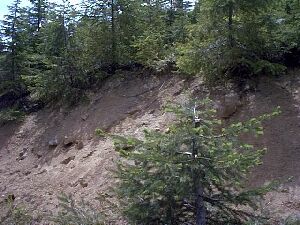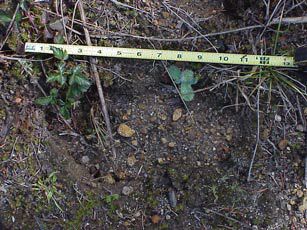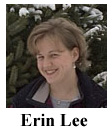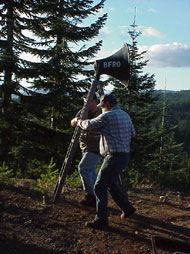|
Thursday, September 21
Once again, most expedition members were up by 9 AM. Though the day started out sunny, the weather took a definite turn for the worse by noon.
The temperature had dropped substantially, hovering in the upper 40's most of the day, and there were intermittent
showers accompanied by some gusty winds most of the afternoon.
Talk around the campfire breakfast centered on the previous evenings vocalization.
Terry and Bambenek recounted their story again, still visibly awed by the raw power
and volume of the screams. It was decided that the group would split up and scour the forest
near the scream's origin to look for prints or other signs of activity. Fish, Noll, Terry, and Bambenek
searched the area that the vocalization came from, on the eastern slope of Hilltop. Henick and Lemley
drove along the surrounding logging roads, looking for tracks in the soft dirt of the embankments before hiking
into Skookum Meadow to look for sign.

Tree with top twisted off near
Skookum Meadow.
Photo by Jeff Lemley.
Noll located an old logging road halfway down the eastern slope of Hilltop. There were several rocks on the road
that had been freshly dislodged, many with the moss scraped off of them. As best as the group could tell, this is where the
vocalizations had emanated from the previous night.

Possible print found on logging road near screams.
Photo by Rick Noll.

Meanwhile, several expedition members traveled to Northwoods again to take showers. Erin Lee
returned to camp at about 1 PM, after a 2-day absence. After completing the search for tracks in the
surrounding forests, most group members returned to camp to relax for the afternoon. Henick left camp to return to
town, and was gone for the remainder of the expedition.
The rain showers finally let up in the late afternoon, and the skies began to clear.
The temperature dropped rapidly after dusk. The group discussed several ideas for the evening's
activities, mainly focusing on how to draw the suspected sasquatch activity in closer to
camp for purposes of obtaining photographic or video evidence.
During this time,
Moneymaker and Lemley had been using the thermal imager to scan the surrounding hillsides, and had
noticed a nondescript hotspot located just below the rocky outcropping at Ridgetop, approximately 500 yards away. The object remained
immobile while they were observing it. Several theories about what the object could be were weighed out,
the most likely being that it may be a rock retaining heat from the day. However, it was now 4 hours after sunset,
and the sun had hardly been out that day at all due to the rain storm. Having ruled out that option,
the group concensus was that it had to be a biological form generating heat.
The object remained motionless while the group viewed it for several more minutes.
It was finally decided that someone should go investigate the anomaly at close range.
Powell, Searle and Lemley volunteered for the duty. Lemley drove the trio to the logging
road that accessed the Ridgetop location. The group parked at the south end of the ridge, and proceeded on foot towards the
north end, where the anomaly was located.
Back at camp, the others continued to monitor the heat source through the thermal camera, prepared to communicate
any change or movement. When the three-man team finally came into view of the thermal at the top of the rocky outcropping,
Randles radioed to inform them that the object was about 30 feet below them on the hillside, and furthermore, it was about
3 times the size of one of the team. This news was somewhat unnerving for the three trying to determine the heat source.
Powell manned the radio while he filmed the proceeding with his Sony Night Shot camcorder.
Lemley and Searle inched their way down the hill, homing in on the heat source thanks to directions
relayed from camp. Finally, the word came that "you're right on top of it!!" Lemley and Searle could find nothing.
After looking around a bit, they noticed some lichens and moss on the face of a large rock at ground zero.
It was possible that either heat was being generated by the decomposing foliage, or the rock had managed to retain
heat from the daylight hours. Everyone was quite impressed that
the thermal unit was sensitive enough to detect such a small temperature difference at such a great distance. Powell, Searle, and Lemley
returned to camp.
Back at camp, the group decided to take the thermal imager and try to do some filming from
Noll's truck while driving the surrounding roads. Searle went along to do the filming, accompanied
by Moneymaker and Noll. Fish was left in charge of broadcast calls at 45 minute intervals. The group hoped that
they may be able to catch a glimpse of an animal or sasquatch moving along the roads in the direction of the
broadcasted calls. Noll, Moneymaker and Searle (the mobile thermal team) departed camp just before midnight.

Moneymaker and Fish set up the broadcasting system.
Photo by Rick Noll.
Fish proceeded with the call broadcasting a few minutes later. Powell, Lemley, Bambenek, Terry, Randles and Lee remained in camp,
as did Pugsley and Mort. The mobile thermal team stopped at the gravel pit located at the start of the road that base camp was located on.
Searle sliced open a melon and placed it on the dirt embankment next to the road, careful not to leave any footprints. They then continued on towards
the southwest, driving very slowly and with the headlights off. Searle was standing up in the vehicle, so that he could film with the thermal unit
from the cartop, via Noll's sunroof.
Just after passing the road that lead to Ridgetop (about 1 mile from base camp) Searle noticed a series of hotspots on the righthand side embankment.
Noll stopped the vehicle, and stepped out to investigate by flashlight. Searle used the thermal unit to guide Noll to the location of the heat sources, as Noll
was unable to see hot spots. Upon zeroing in on the spots, Noll was able to discern scrape marks and impressions that denoted something having travelled along that
path, but they were very light and inconclusive. There were 3 heat spots total, 1 on the road, and 2 in the embankment. We had been informed prior to the trip that the
thermal unit was capable of detecting the residual heat left by a footstep, provided it was a bare foot. Of course, a hooved mammal, such as an elk or deer, could not have left
a detectable level of residual heat. A bear, on the other hand, could have left large, residual heat prints. However, the heat prints that were found were a large distance apart,
although an exact measurement was not obtained. Noll cut another melon in half and left it at this location.
They then continued on towards Lone Butte.
Back at camp, Fish continued to play calls, while the rest of the group sat discussing various topics.
Conversational volume was kept low, though, so that any vocalizations could be heard. Bambenek, Lee, Mort, Terry and Pugsley retired
by 12:30 AM. Lemley retired just before 1 AM. Moments later, Fish and Randles heard a single vocalization.
It came from directly to the south of camp, but was some distance away, perhaps as far as 1 mile. Just a few moments later,
Noll radiod camp, informing them that his alternator had given out, and they were stuck on the south side of Lone Butte, approximately 4 miles
to the south of camp. Fish and Powell departed in Fish's truck to go and jumpstart Noll's vehicle. Randles remained in camp.
The rescue team was successful in jumpstarting Noll's vehicle, but it required several more
jumpstarts during the drive back to camp. Upon returning to the entrance road to base camp, the group checked
the melon that they had placed alongside the road. The melon was gone, and a stick had replaced it. The group continued
on into camp.
After returning to camp, Randles and Fish decided to continue placing fruit
alongside the road in various locations. They departed immediately. Noll, Searle, Powell,
and Moneymaker sat up by the campfire talking for awhile longer. Shortly thereafter, they thought they
heard some garbled vocalizations coming from the thick brush several yards to the east of camp. One of the
expedition members was snoring in their sleep in that same general direction, but Noll stated that he
could definitely discern two separate sources of noise, and that the second noise was coming from well in back of that
particular tent.
Randles and Fish returned from placing fruit just a few minutes later. Upon hearing Noll's
description of the noise, Randles decided to investigate. Searle accompanied him into the 2nd growth trees
located on the east side of camp. Several yards into the trees, both men noticed that what appeared to be pebbles
were falling all around them, much like if someone had picked up a handful of gravel and thrown it at
them. It was pitch dark in the rather thick trees and underbrush, and visibility by flashlight was very
limited, so they decided to return to camp. No other disturbances were noted, and the remainder of the group
retired for the evening.
|





















